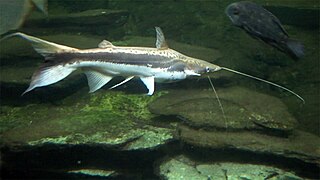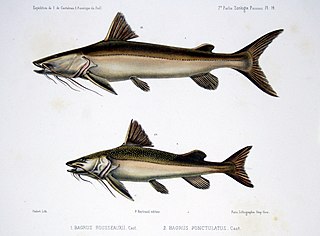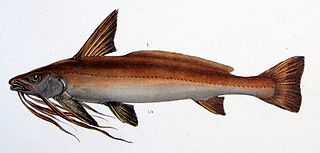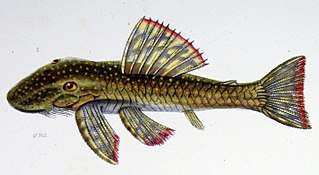
Pseudoplatystoma is a genus of several South American catfish species of family Pimelodidae. The species are known by a number of different common names. They typically inhabit major rivers where they prefer the main channels and tend to stay at maximum depth, but some species can also be seen in lakes, flooded forests, and other freshwater habitats. They have robust bodies, and are important food fish. Recently, their population size has been on the drastic decline due to a variety of factors including overfishing and habitat destruction due to the construction of hydroelectric dams.

The Pimelodidae, commonly known as the long-whiskered catfishes, are a family of catfishes.

Acanthicus is a genus of large, South American suckermouth armored catfishes native to the Amazon and Orinoco basins, and possibly in Guyana. The name Acanthicus is derived from the Greek, akanthikos meaning thorny, spiny. Fish of this genus are known as lyre-tail plecos. These species are found in large rivers, primarily in areas with a rocky bottom and a moderate or strong current.

Sorubim is a small genus of long-whiskered catfish native to tropical South America. A number of characteristics allows the differentiation of each species in the genus. Sorubim species are important food fish in South America and are highly significant to fisheries of some areas; however, harvests of these fish are not identified as much as other, more popular food fishes such as Colossoma, Arapaima, and Brachyplatystoma. Some species of this family are popular aquarium fish.

Brachyplatystoma is a genus of catfish from the family Pimelodidae. As the occasionally used common name goliath catfishes indicates, this genus includes some of the largest species of catfish, including the piraíba, B. filamentosum, which reaches up to the region of 3.6 metres (12 ft) in length. Brachyplatystoma are found in the Amazon and Orinoco basins, and other tropical freshwater and brackish habitats in South America. Some species are migratory. These fish are important as food fish and, to some extent, aquarium fish.

The porthole shovelnose catfish or spotted shovelnose catfish, Hemisorubim platyrhynchos, is the only species in the genus Hemisorubim of the catfish family Pimelodidae.

Pinirampus pirinampu is a species of catfish of the family Pimelodidae. P. pirinampu is also known as the flatwhiskered catfish.
Aguarunichthys is a genus of long-whiskered catfishes native to South America.
Cheirocerus is a genus of long-whiskered catfishes native to South America.

Leiarius is a genus of long-whiskered catfishes native to South America. Most of the genus' species are found in the aquarium hobby as ornamental fish.

Lasiancistrus is a genus of suckermouth armored catfishes. They are native to South America and Panama.
Brachyplatystoma juruense, the zebra catfish, is a species of catfish of the family Pimelodidae that is native to Amazon and Orinoco River basin of Peri and Rio Juruá, northwestern Brazil.

Brachyplatystoma platynemum, The slobbering catfish, is a species of catfish of the family Pimelodidae that ranges from Brazil, Colombia and Venezuela.

Brachyplatystoma vaillantii, the Laulao catfish or piramuta, is a species of catfish of the family Pimelodidae that is native to Amazon and Orinoco River basins and major rivers of the Guianas and northeastern Brazil.
Brachyplatystoma capapretum, the dark caped goliath catfish, also called Peru piraiba catfish or false piraiba, is a species of catfish of the family Pimelodidae that is native to watershed areas of Brazil and Peru.

Brachyplatystoma filamentosum, commonly called piraíba, kumakuma, valentón or lau lau, is a species of catfish of the family Pimelodidae and genus Brachyplatystoma that is native to Amazon and Orinoco River basins and rivers in Guianas and northeastern Brazil.

Brachyplatystoma rousseauxii, the gilded catfish or dourada, is a species of catfish of the family Pimelodidae that is native to Amazon and Orinoco River basins and major rivers of French Guiana.
Aguarunichthys inpai, is a species of benthopelagic catfish of the family Pimelodidae that is native to middle Amazon River basin of Brazil.
The Tocantins Pimelodus,, is a species of benthopelagic catfish of the family Pimelodidae that is native to Brazil.

Leiarius pictus, commonly as sailfin pim, painted catfish or saddle catfish, is a species of demersal catfish of the family Pimelodidae that is native to Amazon, Essequibo, and Orinoco River basins of Colombia, Venezuela, Peru and Brazil.













